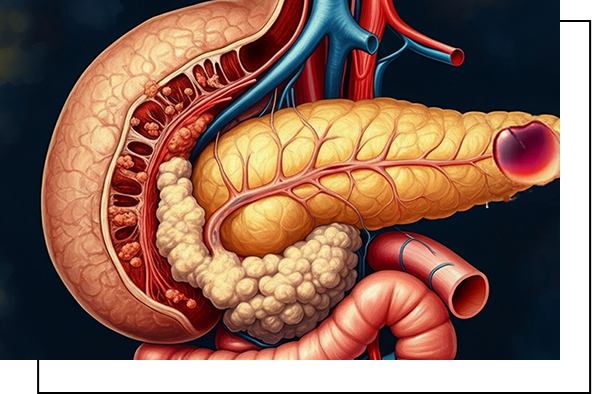Cystic Neoplasm Of Pancreas Treatment in Kolkata
Home > Pancreatic Diseases > Cystic Neoplasm Of Pancreas
Overview
Cystic neoplasms of the pancreas are a group of tumor-like fluid-filled growths that develop within the pancreas. While many are benign, some carry a risk of becoming cancerous. If you’re experiencing symptoms, consulting Dr. Debjoy Sau, a reputed doctor for effective pancreatic cysts treatment in Kolkata helps in accurate diagnosis and personalized care.


Types of Cystic Neoplasms of the Pancreas
The most common cystic neoplasms of the pancreas include:
Serous Cystadenomas
Typically benign and rarely cause symptoms.
Mucinous cystic neoplasms
Mostly found in middle-aged women compared to men and have potential for malignancy.
Solid pseudopapillary neoplasms
Rare but more common in young women; low-grade malignancy potential.
Intraductal papillary mucinous neoplasms
These cysts can form in the central pancreatic duct or its branches. These can be benign, precancerous, or cancerous.

Symptoms
Cystic neoplasms of the pancreas often don’t cause any symptoms, especially in the early stages. However, if a cyst grows large, you may experience:
Upper abdominal pain or discomfort
Early satiety (feeling full after eating a small amount of food)
Unexplained weight loss
Yellowing of the skin and eyes (jaundice)
Nausea or vomiting
A palpable lump in the abdomen
Nausea or vomiting
A palpable lump in the abdomen
Book An Appointment
Causes and Risk Factors
The most common triggers include:
Family history of pancreatic disease
Smoking or heavy alcohol consumption
Obesity and a sedentary lifestyle
Genetic mutations or inherited conditions

Complications from Cystic Neoplasms of the Pancreas
Untreated cystic neoplasms of the pancreas can lead to:
Risk of malignant transformation, particularly in mucinous cysts and IPMNs.
Rupture, causing severe abdominal pain.
Infection or inflammation
Pancreatic duct blockage
Development of diabetes
Digestive problems
Compression of nearby organs.
Evaluation
In Kolkata, pancreas specialist doctors use advanced diagnostic tools and methods:
High-resolution CT scans
MRI with contrast
Endoscopic ultrasound
Biopsy
Blood marker tests
Fluid Analysis

Management
Visit a doctor for cystic neoplasm of pancreas treatment in Kolkata for an expert diagnosis and tailored treatment plan.
Regular monitoring through imaging
Endoscopic therapy or endoscopic drainage
Surgical removal when necessary
Lifestyle modifications
Book An Appointment
FAQs
Know Your Answers
Can cystic neoplasms of the pancreas be cured?
In some cases, cystic neoplasms of the pancreas can be cured with surgery. Also, some types of cysts may require continued monitoring or treatment.
What size of pancreatic cyst is concerning?
Cysts larger than 3cm typically require closer monitoring and possible intervention.
Are all pancreatic cysts treated surgically?
No, small and benign cysts are often monitored unless symptoms or risks increase.
How often should pancreatic cysts be monitored?
Regular monitoring every 6-12 months with imaging studies, depending on cyst size and characteristics.
How successful is pancreatic cyst surgery?
Success rates are high when performed by experienced surgeons, with most patients recovering fully.

